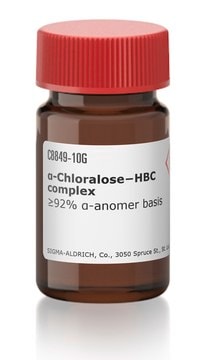23120
Chloralose
≥98.0% (chloralose, AT)
Sinónimos:
1,2-O-(2,2,2-Trichloroethylidene)-α-D-glucofuranose, Anhydro-D-glucochloral, Chloralose
About This Item
Productos recomendados
assay
≥98.0% (chloralose, AT)
form
powder
optical activity
[α]20/D +17±2°, 5 hr, c = 2% in ethanol
impurities
15% Beta-chloralose
mp
178-184 °C
solubility
water: soluble 1 gm in 225 ml at 15 °C
chloroform: slightly soluble
diethyl ether: soluble
glacial acetic acid: soluble
petroleum ether: insoluble
SMILES string
OC[C@@H](O)[C@H]1O[C@@H]2O[C@@H](O[C@@H]2[C@H]1O)C(Cl)(Cl)Cl
InChI
1S/C8H11Cl3O6/c9-8(10,11)7-16-5-3(14)4(2(13)1-12)15-6(5)17-7/h2-7,12-14H,1H2/t2-,3+,4-,5-,6-,7-/m1/s1
InChI key
OJYGBLRPYBAHRT-IPQSZEQASA-N
¿Está buscando productos similares? Visita Guía de comparación de productos
Biochem/physiol Actions
Components
Other Notes
signalword
Danger
hcodes
Hazard Classifications
Acute Tox. 3 Oral - Acute Tox. 4 Inhalation - Aquatic Acute 1 - Aquatic Chronic 1 - STOT SE 3
target_organs
Central nervous system
Storage Class
6.1D - Non-combustible acute toxic Cat.3 / toxic hazardous materials or hazardous materials causing chronic effects
wgk_germany
WGK 1
flash_point_f
Not applicable
flash_point_c
Not applicable
ppe
dust mask type N95 (US), Eyeshields, Faceshields, Gloves
Certificados de análisis (COA)
Busque Certificados de análisis (COA) introduciendo el número de lote del producto. Los números de lote se encuentran en la etiqueta del producto después de las palabras «Lot» o «Batch»
¿Ya tiene este producto?
Encuentre la documentación para los productos que ha comprado recientemente en la Biblioteca de documentos.
Nuestro equipo de científicos tiene experiencia en todas las áreas de investigación: Ciencias de la vida, Ciencia de los materiales, Síntesis química, Cromatografía, Analítica y muchas otras.
Póngase en contacto con el Servicio técnico









